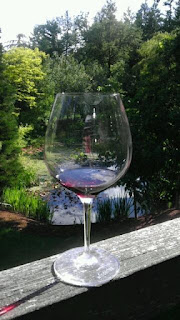This is a
sample of how we prepare for our “wine school”. I hope it will help inspire you
to learn more about wine.
Objective: To explore, taste and experience three unfamiliar Spanish
white wines.
Wines: Martin Cόdax Albariῆo
2010 ($12.99 at multiple retailers); Louro Do Bolo Godello 2009 ($16.99 at The
Wine Merchant); Hermanos Lurton Verdejo 2010 ($11.99 at Whole Foods)
Preparation:
This is where our group takes turns
being the “teacher”. We rotate who will
host the evening. The host is then responsible for the topic of the evening and
background research of the wines being served and the region they come from.
With this class the grapes were unfamiliar to us, so we spent a lot of time
talking about the grapes, and where they grow in Spain along with the climate
and even some interesting historical facts about Spain. We have some great resources
listed on the blog that can be used as references. Also, make yourself aware of
the wine laws in the countries or regions you are learning about. As part of
our research, we find some small pairings that should work well with our wines
of the evening. We always have some cheese for pairing, and Spanish Manchego
cheese was a perfect pairing with Spanish wines. We also tried pairing Goat
Gouda cheese, Rembrandt Extra Aged Gouda, and guacamole. Usually, we add some
chocolate too when serving red wines.
Set up:
Place three glasses at each place
setting; a tasting note sheet (www.wine-tastings-guide.com/wine-tasting-notes-template.html );
small plate; napkin; and pen. It is helpful that at least one item,
example tasting sheet or plate, is white to use a background when
distinguishing the color/appearance of the wine. Make sure you have the wines
at the correct temperature. Whites should not be straight out of refrigerator,
let them sit out 15-20 minutes.
Swirl, Smell, Taste: Time
to begin. Over time we have found it helpful to try each wine one by one
without adding any pairings. Basically we follow the tasting note sheet listed
above. First we look at the appearance of the wine. Is it straw yellow, golden,
etc. Next we give the wine a good swirl to get the aromas going. Take a deep
whiff of the wine – what do you smell? Remember there is no wrong answer. It
takes practice and helps discussing with others what you smell. A great source
I found recently is The Wine Aroma Wheel, www.winearomawheel.com. And finally,
it is time to taste. Try to leave the wine in your mouth for about 30 seconds
if you can and swish it around if that feels comfortable to you. Don’t be
surprised if with the second sip the flavor is enhanced. Sometimes it takes the
first sip to coat the tongue with the flavors of the wine. Discuss and make
notes regarding the taste. Some things to consider, tannins, acidity, mouth
feel, type of fruit, etc. Repeat this with the next two wines. Try and hold off
on the snacks until you have tried all of the wines. The food will change the
palate.
Add Some Nibbles: Now it is time to start experimenting with the food. Pick a
cheese and try with each wine. Is there a wine that works better with a
specific cheese? We like to leave room on our tasting sheet to add notes about
the wine with the pairings. Make sure you sniff the wines when you try them
again. You will be amazed how the nose may change as the wine opens up.
Final Thoughts: Be creative and do what works for you
and your group. This is just a sample from one of our classes. We have done
blind tastings as well. Sometimes we have added in the game, Winerd, which is a
lot of fun. If you are nervous about starting this up on your own, I highly
recommend the book, Great Wine Made
Simple, by Andrea Immer Robinson. Her book takes you through the great
grapes of the world and has tastings for you to try. Our first classes were
based on her teachings; after we started feeling more comfortable we started
adapting or adding on to her tastings to fit our needs. Before you knew it, we
were designing our own classes. Remember, wine and foods are meant to be shared
and enjoyed with friends.
Cheers,
Beth
Wine Fact: Every wine contain some sulfites. They result as a natural by-product of the fermentation process.
Wine Fact: Every wine contain some sulfites. They result as a natural by-product of the fermentation process.
